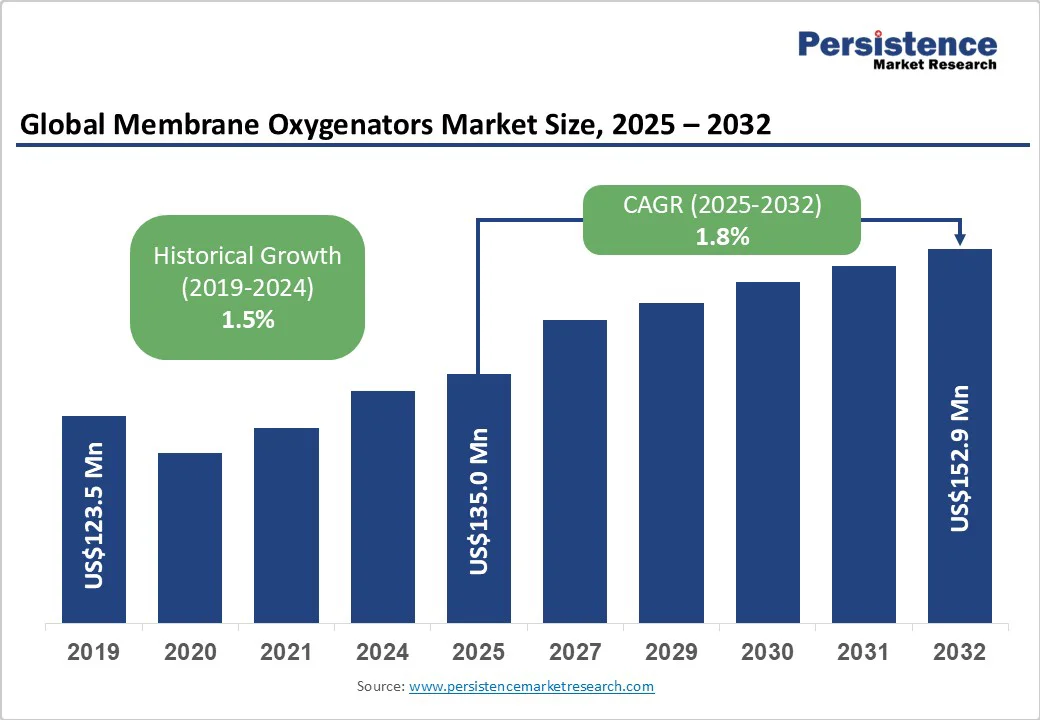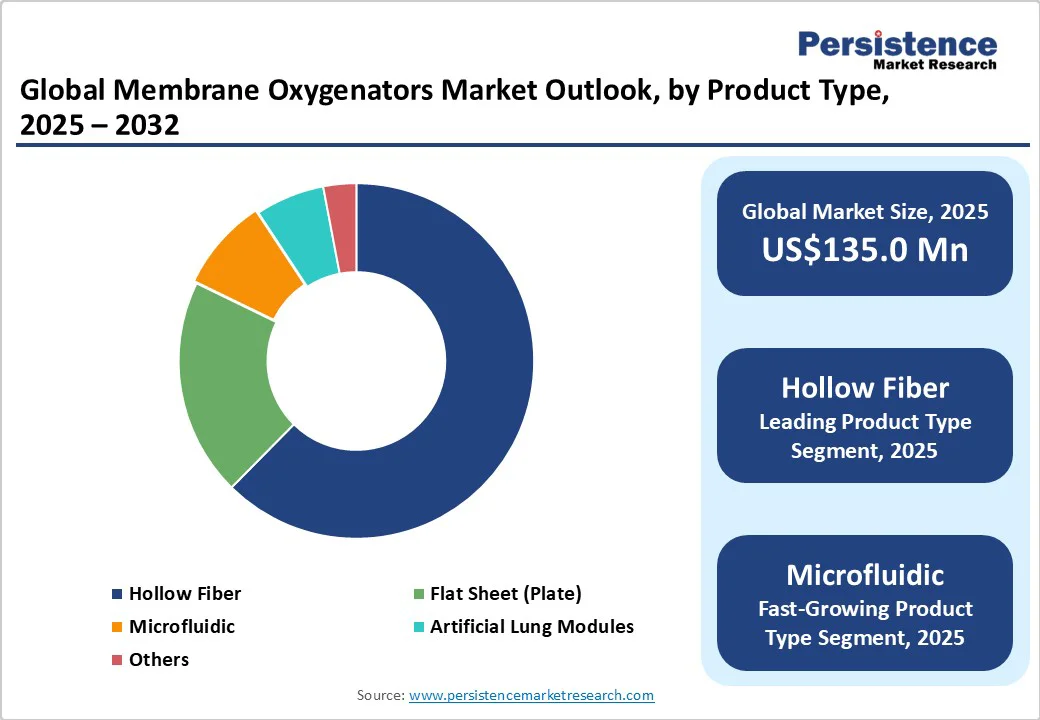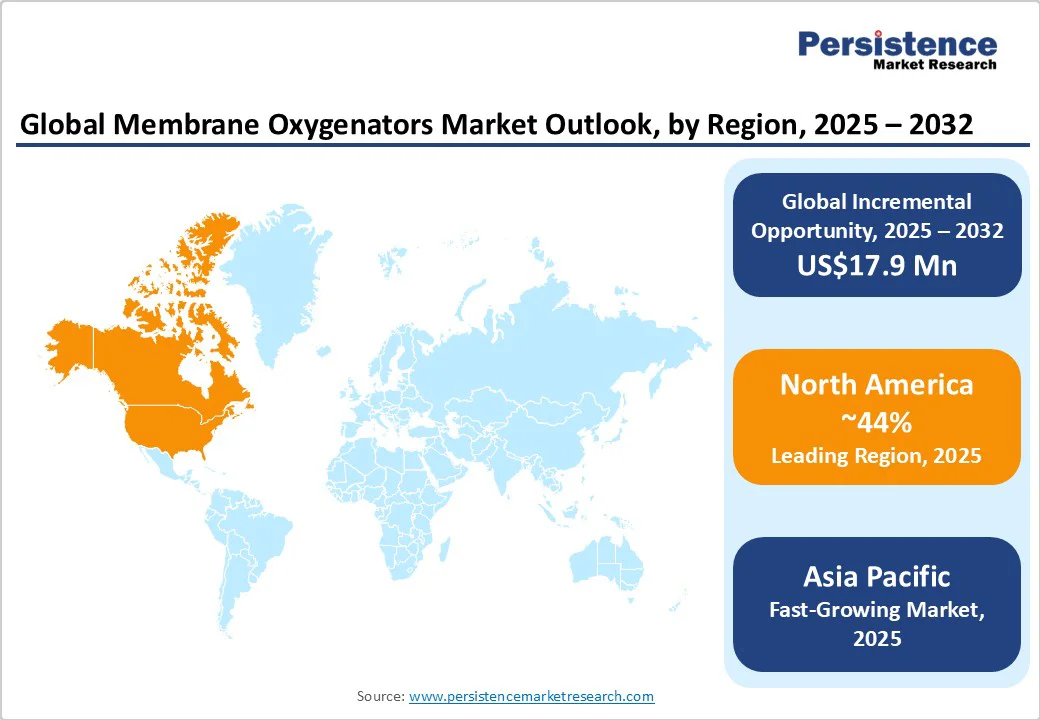ID: PMRREP33254| 217 Pages | 8 Oct 2025 | Format: PDF, Excel, PPT* | Healthcare

The global membrane oxygenators market size is likely to be valued at US$135.0 Million in 2025 and is estimated to reach US$152.9 Million by 2032, growing at a CAGR of 1.8% during the forecast period 2025 - 2032, driven by the rising incidence of cardiovascular and respiratory diseases worldwide, leading to greater demand for advanced extracorporeal life support (ECLS) solutions in both adult and pediatric patient populations.
Hollow fiber membrane oxygenators, now accounting for over 40% of adoption in critical care and cardiac procedures, are gaining traction alongside new biocompatible materials. Strong hospital uptake is fueled by innovation and favorable healthcare funding in North America and Europe.
| Key Insights | Details |
|---|---|
| Membrane Oxygenators Market Size (2025E) | US$135.0 Mn |
| Market Value Forecast (2032F) | US$152.9 Mn |
| Projected Growth (CAGR 2025 to 2032) | 1.8% |
| Historical Market Growth (CAGR 2019 to 2024) | 1.5% |

The membrane oxygenators market is witnessing steady growth, driven by the rising prevalence of cardiopulmonary disorders such as coronary artery disease and acute respiratory distress syndrome (ARDS). According to the World Health Organization (WHO), cardiovascular diseases claim over 17.9 million lives annually, with more than 30% of these cases requiring advanced life support interventions.
The growing demand for ECMO (extracorporeal membrane oxygenation), especially for conditions such as COVID-19-induced respiratory failure, is significantly enhancing market potential. Supportive government initiatives, including CMS reimbursement in the U.S. and similar programs in the EU, are enabling hospitals to invest in cutting-edge oxygenator systems.
Technological advancements are also reshaping the landscape. The FDA’s approval of next-generation hollow fiber oxygenators using polymethylpentene materials has improved biocompatibility, reducing thrombogenic risks. Companies such as Medtronic are spearheading innovation, as seen in the 2024 launch of the VitalFlow ECMO system, which features automated gas exchange and real-time analytics.
Additionally, the integration of AI-driven diagnostics and perfusion monitoring tools is enhancing precision in critical care. These innovations are expanding the clinical applications of membrane oxygenators into artificial lung technologies and pediatric care, while encouraging ongoing upgrades and adoption across global hospital networks.
Despite rising demand, the high capital and operational costs of membrane oxygenators remain a major hurdle, particularly for resource-constrained facilities. A complete oxygenator suite can cost between US$40,000 and US$60,000, with annual expenditures on maintenance, staff training, and consumables adding up to 25% of the initial investment.
In emerging markets, including India and Brazil, tight healthcare budgets and limited reimbursement structures hamper broader adoption, especially in smaller clinics and ambulatory surgical centers. Without enhanced government or payer support, many providers restrict purchases to basic functionalities, sidelining advanced technologies and reducing the addressable patient base.
Regulatory challenges further complicate market expansion. Agencies such as the FDA, EMA, and counterparts in Asia Pacific mandate extensive clinical trials, safety monitoring, and rigorous post-market surveillance. In 2023, several ECMO-related product approvals experienced delays of up to 18 months in both the U.S. and the EU.
Additionally, exports to China face evolving tariffs and requirements for localized clinical validation, delaying time-to-market. These regulatory complexities heighten investor risks and cause a disadvantage to smaller or newer entrants, ultimately slowing the pace of innovation and limiting access to next-generation oxygenator technologies in critical care settings worldwide.
The convergence of membrane oxygenators with AI-based monitoring modules constitutes a major future opportunity. Data-driven platforms enable real-time performance analysis and predictive clinical support, enhancing both device and outcome optimization. Industry estimates suggest the digital oxygenator solutions market could grow by US$120 Million in incremental revenue by 2032, with adoption rates exceeding 35% among tertiary care centers.
As companies focus on interoperability, cloud connectivity, and telemedicine-augmented follow-up, new business models, such as subscription analytics and remote device management, are emerging. Providers that invest in R&D for AI integration and secure regulatory approval will capture disproportionate market share and achieve measurable improvements in patient survival and hospital efficiency.
In developing economies, governments are funneling resources into cardiopulmonary care via national insurance programs such as China's Basic Medical Insurance and India's Ayushman Bharat, aiming to lower the incidence and mortality from respiratory and cardiac diseases.
As the number of accredited ECMO centers surges, the addressable market for membrane oxygenators could exceed US$350 Million in Asia Pacific by 2032. Multinationals and local players alike are exploring strategic partnerships to localize manufacturing and meet price-sensitive demand, positioning themselves for accelerated revenue growth.
Hollow fiber membrane oxygenators are forecast to account for 62.4% of the market share in 2025, aided primarily by their superior gas exchange efficiency, scalability, and compatibility with modern ECMO systems. These devices are extensively used in advanced cardiac surgery and critical care, underpinning hospital procurement trends in North America and Europe. The emergence of polymethylpentene-based hollow fiber units is elevating device safety by lowering thrombogenic risk and improving longevity, thus reinforcing their leadership.
The fastest-growing product segment is set to be microfluidic membrane oxygenators, which are projected to achieve a CAGR of about 9.2% from 2025 to 2032. This growth is catalyzed by the ability to deliver targeted perfusion solutions for complex neonatal and pediatric applications, as well as in research settings exploring artificial lung technologies. Strategic investments by leading manufacturers and early regulatory approvals will continue to drive adoption and new clinical indications, especially within centers of excellence in Asia and Europe.
Adults represent the largest age group, expected to command approximately 69.0% of the market revenue share in 2025. This dominance reflects the high prevalence of cardiovascular and respiratory conditions among adult patients, along with the demand for advanced life support during cardiac and pulmonary interventions in tertiary hospitals. Chronic conditions, rising procedural volumes, and lifestyle risk factors are anticipated to sustain segmental leadership and drive multi-modal device utilization.
Meanwhile, neonates and pediatrics form the fastest-growing age-based segment, achieving an estimated CAGR of 7.8% from 2025 to 2032. Increased birth rates coupled with the growing incidence of congenital heart and lung conditions are catalyzing rapid market expansion across specialized pediatric hospitals in Asia Pacific and Europe. Early device miniaturization and the launch of biocompatible membrane oxygenators approved for neonatal use are unlocking significant growth potential for manufacturers targeting pediatric indications.
Cardiac surgery remains the leading application, holding an estimated 56.5% share of the market in 2025. Robust volumes in coronary artery bypass grafting, heart failure management, and post-transplant care underpin this dominance, with hospital networks routinely upgrading to advanced hollow fiber oxygenator systems. Macroeconomic and epidemiological trends, particularly the surge in complex cardiac and post-ischemic cases, are boosting technology replacement cycles and overall market size.
Respiratory failure and critical care management, including emergent applications in ARDS, pneumonia, and infectious respiratory diseases, is projected to be the fastest-growing sub-segment, with a CAGR of 7.4% through 2032. ECMO utilization for acute respiratory events, amplified during recent influenza and COVID-19 outbreaks, leads to enlarged device footprint and elevated procurement rates within integrated care pathways in the U.S., the EU, and Asia Pacific. Innovations in membrane materials and AI-enabled perfusion control are accelerating this growth and creating new opportunities for cross-segment collaborations and product launches.

North America is anticipated to lead the market with a share of 44.2% in 2025, supported by robust hospital infrastructure, high procedural volumes, and expansive reimbursement frameworks. The U.S. alone accounted for approximately US$44.2 Million in revenue in 2024, growing at a CAGR of 1.4% through 2032.
Strong regulatory environments, including FDA fast-track approvals for innovative oxygenators, plus consistent investments in ECMO centers, position North America as a critical hub for innovation and strategic partnerships. The competitive landscape is highly consolidated, with Medtronic, Getinge AB, and Terumo Corporation holding dominant positions through continuous R&D and high-profile M&A transactions. Investment trends focus on technology upgrades, particularly in digital health integration and biocompatibility, creating long-term opportunities for both incumbent and new entrants.
Europe is experiencing continuous expansion, capturing a 30.2% of the market share in 2025 and projected to grow at a CAGR of 2.8% through 2032. Germany, the U.K., and France remain the largest contributors, backed by well-developed healthcare systems, government-funded ECMO programs, and broad clinical adoption. The adoption of pan-European regulatory processes, harmonized by the EMA, has accelerated clinical validation and market entry for new technologies.
Major players such as Fresenius Medical Care AG & Co. KGaA and Drägerwerk AG & Co. KGaA benefit from cross-country collaborations and regulatory harmonization, translating into efficient pan-regional commercialization. Investment flows increasingly target innovation, particularly in miniaturized devices and eco-friendly sterile consumables. Ongoing public-private partnerships will continue to drive growth and competitive differentiation across the continent.
Asia Pacific is forecasted as the fastest-growing regional market, with a projected CAGR of 7.2% from 2025 to 2032 and an anticipated 2025 market share of 21.8%. China, Japan, and India are leading adoption through strong government policy backing, scalable hospital infrastructure development, and rising incidence of pertinent conditions, especially among aging and pediatric populations. Manufacturing advantages and cost efficiency empower local and multinational firms to ramp up production capacity and address price-sensitive public sector demand.
Competitive dynamics are becoming more fragmented as numerous regional companies enter the market, and multinationals drive localization through technology transfer partnerships. Investment priorities include R&D for neonatal and pediatric indications, expansion of ECMO training centers, and accelerating regulatory approvals for next-generation oxygenator membranes, contributing to sustainable long-term growth.

The global membrane oxygenators market is moderately consolidated, with top players-Medtronic PLC, Getinge AB, Terumo Corporation, Fresenius Medical Care AG & Co. KGaA, and LivaNova PLC-projected to account for over 62% of global revenue by 2025.
These leaders sustain dominance through broad product portfolios, extensive distribution networks, and continuous clinical innovation. The rest of the market comprises regional and emerging manufacturers, fostering both competition and collaboration. Competitive positioning is driven by patent strength, regulatory speed, and integrated extracorporeal life support capabilities.
High market concentration creates entry barriers, yet supports fast-track commercialization of advanced technologies. Leading firms focus on innovation-led differentiation, regulatory agility, and strategic partnerships. Cost efficiency is achieved via localized production and optimized supply chains.
Evolving business models emphasize subscription-based analytics and bundled services, offering comprehensive critical care solutions. Integration with digital health tools and continuous clinician training further strengthens customer loyalty and expands global reach, reinforcing long-term competitive advantage.
The membrane oxygenators market is projected to reach US$135 Million in 2025.
The rising incidence of cardiovascular and respiratory diseases worldwide, leading to greater demand for advanced extracorporeal life support (ECLS) solutions in both adult and pediatric patient populations, is driving the market.
The membrane oxygenators market is poised to witness a CAGR of 1.8% from 2025 to 2032.
The convergence of membrane oxygenators with AI-based monitoring modules and the funneling of resources into cardiopulmonary care via national insurance programs by governments in emerging economies are key market opportunities.
Medtronic PLC, Getinge AB, and Terumo Corporation are some of the key players in the membrane oxygenators market.
| Report Attribute | Details |
|---|---|
| Historical Data/Actuals | 2019 - 2024 |
| Forecast Period | 2025 - 2032 |
| Market Analysis | Value: US$ Mn |
| Geographical Coverage |
|
| Segmental Coverage |
|
| Competitive Analysis |
|
| Report Highlights |
|
By Product Type
By Age Group
By Application
By Region
Delivery Timelines
For more information on this report and its delivery timelines please get in touch with our sales team.
About Author